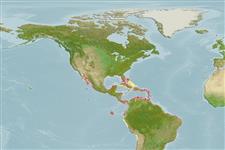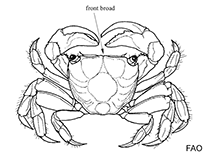Aratus pisonii (Milne-Edwards, 1837)
Mangrove tree crab| Native range | All suitable habitat | Point map | Year 2050 |

|
| This map was computer-generated and has not yet been reviewed. |
| Aratus pisonii AquaMaps Data sources: GBIF OBIS |
Google image | No image available for this species;
drawing shows typical species in Sesarmidae.
Classification / Names Common names | Synonyms | CoL | ITIS | WoRMS
Malacostraca | Decapoda | Sesarmidae
Environment: milieu / climate zone / depth range / distribution range Ecology
Benthic; brackish; depth range 0 - 2 m (Ref. 97531). Tropical; 30°N - 28°S, 114°W - 34°W
Distribution Countries | FAO areas | Ecosystems | Occurrences | Introductions
Eastern Pacific and Western Atlantic: Eastern Florida, to southern Gulf of Mexico, Antilles to Brazil, and in the eastern Pacific from Gulf of California, Mexico, to Peru.
Length at first maturity / Size / Weight / Age
Maturity: Lm ? range ? - ? cm Max length : 2.7 cm CW male/unsexed; (Ref. 111236); 2.46 cm CW (female)
Life cycle and mating behavior Maturity | Reproduction | Spawning | Eggs | Fecundity | Larvae
Main reference
References | Coordinator | Collaborators
Bright, T.J. 2010 A list of species from Glover's Reef Atoll, Belize. Wildlife Conservation Society. http://wcsgloversreef.org/LinkClick.aspx?fileticket=PBNMdMHt15g%3D&tabid=1207&language=en-US [Accessed 22/11/2010]. (Ref. 85586)
IUCN Red List Status
(Ref. 130435: Version 2025-1)
CITES status (Ref. 108899)
CMS (Ref. 116361)
Threat to humans
Human uses
Fisheries: commercial
| FishSource |
Tools
More information
Max. ages / sizes
Length-weight rel.
Length-length rel.
Length-frequencies
Mass conversion
Abundance
Internet sources
BHL | BOLD Systems | CISTI | DiscoverLife | FAO(Publication : search) | Fishipedia | GenBank (genome, nucleotide) | GloBI | Gomexsi | Google Books | Google Scholar | Google | PubMed | Tree of Life | Wikipedia (Go, Search) | Zoological Record



